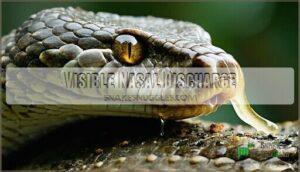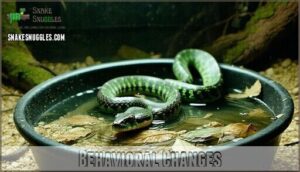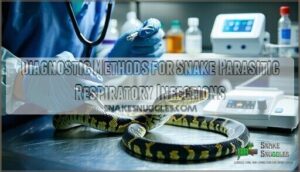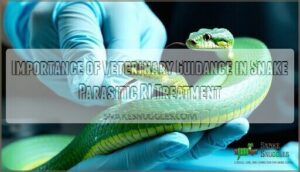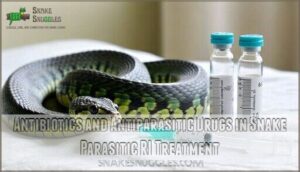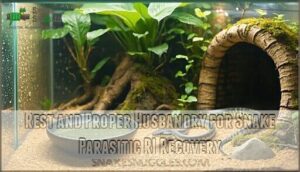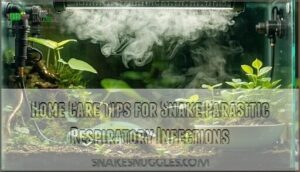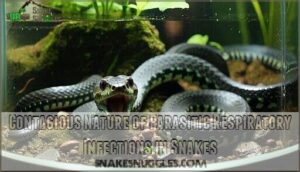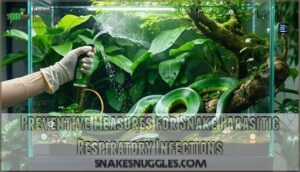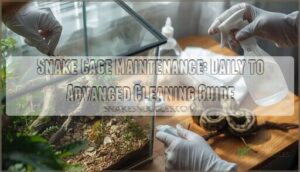This site is supported by our readers. We may earn a commission, at no cost to you, if you purchase through links.
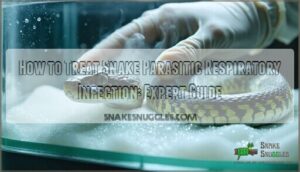
First, crank up the heat and humidity in your snake’s enclosure – think tropical vacation vibes.
Your vet will likely prescribe specific antiparasitic medications or antibiotics targeting the culprits causing trouble.
Nebulization therapy works wonders, delivering medicine straight to those infected airways like a targeted strike.
Don’t forget supportive care: proper nutrition, hydration, and stress-free environment.
Home remedies won’t cut it here – this isn’t a cold that’ll pass with chicken soup.
Professional treatment makes all the difference between recovery and serious complications.
Table Of Contents
- Key Takeaways
- How to Treat Snake Parasitic Respiratory Infection?
- Identifying Symptoms of Snake Parasitic Respiratory Infection
- Diagnostic Methods for Snake Parasitic Respiratory Infections
- Importance of Veterinary Guidance in Snake Parasitic RI Treatment
- Antibiotics and Antiparasitic Drugs in Snake Parasitic RI Treatment
- Nebulization Therapy for Snake Parasitic Respiratory Infections
- Rest and Proper Husbandry for Snake Parasitic RI Recovery
- Home Care Tips for Snake Parasitic Respiratory Infections
- Managing Nutrition and Hydration for Snakes With Parasitic RI
- Contagious Nature of Parasitic Respiratory Infections in Snakes
- Preventive Measures for Snake Parasitic Respiratory Infections
- Frequently Asked Questions (FAQs)
- How do you treat a snake respiratory infection?
- Do snakes have respiratory infections?
- How is bacterial pneumonia treated in reptilian snakes?
- How do you get rid of a respiratory infection in a snake?
- What antibiotics are used for snake respiratory infections?
- What does a respiratory infection look like on a snake?
- How to get rid of parasites in snakes?
- Can snakes develop immunity to parasitic respiratory infections?
- How long can snakes survive with untreated parasitic RI?
- Are certain snake species more susceptible to parasitic RI?
- Conclusion
Key Takeaways
- Get professional help immediately – You can’t treat parasitic respiratory infections at home with DIY remedies, so contact an exotic vet as soon as you notice wheezing, mouth breathing, or nasal discharge.
- Follow prescribed medication protocols – Your vet will prescribe specific antiparasitic drugs and antibiotics, often combined with nebulization therapy that delivers medicine directly to your snake’s airways.
- Optimize your snake’s environment – Maintain proper temperature (75-85°F) and humidity levels while providing a stress-free quarantine setup with clean substrate and hiding spots.
- Prevent future infections through quarantine – Isolate new snakes for at least 30 days, maintain strict hygiene with separate cleaning tools, and schedule regular vet checkups to catch problems early.
How to Treat Snake Parasitic Respiratory Infection?
When your snake develops a parasitic respiratory infection, swift action saves lives.
First, spot the warning signs: labored breathing, nasal discharge, and unusual lethargy signal trouble brewing. Don’t attempt DIY treatments—parasitic infections demand professional veterinary care immediately.
Your vet will diagnose through physical exams and lab cultures, then prescribe targeted antiparasitic drugs and antibiotics. Nebulization therapy delivers medication directly to affected airways, while supportive therapies boost recovery.
Watch for drug resistance and emerging parasites that complicate treatment. Proper husbandry prevents long-term effects—maintain ideal temperatures and humidity.
With novel therapies advancing, your scaly friend’s prognosis improves substantially when caught early.
Identifying Symptoms of Snake Parasitic Respiratory Infection
You’ll notice your snake’s breathing problems before anything else gets serious. Watch for wheezing sounds, mouth breathing, or that weird clicking noise that means trouble’s brewing in their respiratory system.
Abnormal Breathing Patterns
When you spot abnormal breathing patterns, you’re seeing your snake’s body struggling against parasitic invaders. Early indicators include wheezing, mouth-breathing, and labored respiration that signal respiratory distress from parasites.
Here’s your Breathing Sound Analysis checklist:
- Wheezing sounds – high-pitched whistling during breathing
- Clicking noises – sharp sounds indicating airway obstruction
- Open-mouth breathing – severe sign requiring immediate attention
- Shallow, rapid breaths – body compensating for reduced oxygen
- Silent breathing – sometimes more concerning than noisy breathing
Pattern Differentiation helps identify Underlying Causes. Severity Assessment determines if antiparasitic drugs are needed immediately. Don’t wait – snake parasitic respiratory infection worsens quickly without treatment.
Visible Nasal Discharge
Discharge Consistency matters when you’re checking your snake’s nose. You’ll notice thick, sticky mucus that’s different from normal moisture.
Discharge Color ranges from clear to yellow or green, with darker shades indicating Discharge Severity.
Associated Symptoms include mouth breathing and visible nasal discharge around nostrils.
This combo screams snake parasitic respiratory infection requiring antiparasitic drugs and nebulization therapy for parasitic respiratory infections.
Behavioral Changes
Beyond visible discharge, you’ll spot behavioral changes that signal snake parasitic respiratory infection.
Your pet’s activity levels drop dramatically, and appetite loss becomes obvious.
Watch for these warning signs:
- Increased hiding behavior and avoiding normal basking spots
- Lethargy signs like sluggish movement and reduced responsiveness
- Less social interaction during typical handling times
These shifts often appear before breathing problems worsen.
Antiparasitic drugs can’t work effectively if snake parasites have already triggered severe parasitic respiratory infections.
Diagnostic Methods for Snake Parasitic Respiratory Infections
When your snake shows signs of respiratory trouble, you’ll need proper diagnostic tests to pinpoint the exact problem and create an effective treatment plan.
Your vet will use a combination of physical exams, X-rays, and lab work to figure out which parasites are causing the infection and how severe it’s gotten, using effective methods to determine the best course of action.
Physical Examinations and Radiography
After recognizing the warning signs, your vet will perform physical examinations to assess your snake’s clinical assessment.
They’ll check for nasal discharge and listen for unusual breathing sounds during this hands-on evaluation.
Radiography becomes your detective tool here—X-rays reveal internal issues within lung tissue that you can’t see.
This imaging helps with pathogen identification and severity assessment of the snake parasitic respiratory infection, giving your vet the full picture needed for treatment.
Laboratory Testing and Cultures
After physical exams, your vet will collect samples for laboratory testing and cultures.
This pathogen identification process pinpoints exactly what’s causing the infection.
Sample collection might include throat swabs or lung washes for PCR testing and fungal cultures.
These tests reveal antibiotic resistance patterns and detect parasites that standard exams miss.
Culture results guide whether you’ll need antibiotics or antiparasitic medications – it’s like getting a roadmap for treatment instead of guessing what’ll work.
Importance of Veterinary Guidance in Snake Parasitic RI Treatment
After identifying the parasites causing your snake’s respiratory infection, you’ll need professional guidance to tackle this health challenge effectively.
Think of your veterinarian as your snake’s personal health detective and treatment coordinator.
Here’s why veterinary guidance matters for your snake’s recovery:
- Expert Diagnosis: Vets pinpoint exactly which parasites are causing trouble, whether it’s roundworms, coccidia, or flatworms lurking in your pet’s system.
- Treatment Efficacy: They’ll create a targeted treatment plan using specific antiparasitic medications that match your snake’s infection type and severity.
- Medication Safety: Professional oversight guarantees proper dosing of antibiotics and antiparasitic drugs while monitoring for side effects or complications.
Your vet understands how snake parasitic respiratory infection develops and spreads.
They’ll also advise on proper enclosure cleaning to prevent reinfection.
They’ll assess your snake’s overall health, check for secondary infections, and provide preventative care strategies.
Without veterinary guidance, you’re basically flying blind in a complex medical situation.
Professional treatment dramatically improves your snake’s chances of full recovery and protects their long-term health.
Antibiotics and Antiparasitic Drugs in Snake Parasitic RI Treatment
After your vet diagnoses snake parasitic respiratory infection, they’ll prescribe targeted medications that pack a one-two punch against both the parasites and secondary bacterial infections.
Your reptile parasite treatment typically combines antiparasitic drugs like ivermectin or fenbendazole with antibiotics such as enrofloxacin. Think of it as bringing both a fly swatter and bug spray to handle the problem completely.
Reptiles often suffer due to poor husbandry practices, which can substantially increase the risk of respiratory infections.
| Medication Type | Common Examples |
|---|---|
| Antiparasitic Drugs | Ivermectin, Fenbendazole |
| Antibiotics | Enrofloxacin, Ampicillin |
| Combination Therapy | Both types together |
Drug resistance can make treatment tricky, so your vet might run cultures first. Watch for fungal co-infections – they’re like uninvited party crashers that complicate recovery.
Medication administration varies from oral doses to injections, with treatment duration spanning weeks depending on severity.
Supportive care during this time helps your snake bounce back faster. Follow dosing schedules religiously – consistency wins the battle against these microscopic troublemakers.
Nebulization Therapy for Snake Parasitic Respiratory Infections
While antibiotics tackle the infection itself, nebulization therapy delivers medication straight to your snake’s lungs like a targeted missile.
You’ll need a mesh or ultrasonic nebulizer – these Nebulizer Types work best for Drug Delivery to reptiles.
Treatment Duration typically runs 10-20 minutes per session, but don’t rush it.
Your vet will prescribe specific medications for those stubborn parasites causing the snake respiratory infection.
Critically ill patients sometimes require nebulized antibiotics for ventilator-associated pneumonia.
Watch your pet’s stress levels during treatment – Snake Stress can actually worsen reptile respiratory disease.
Keep Humidity Concerns in check by monitoring your enclosure’s environment.
The nebulization therapy works better when your snake isn’t fighting both snake parasitic respiratory infection and poor husbandry.
Clean your equipment between sessions to prevent reinfection.
Most snakes tolerate this treatment well once they get used to it.
Rest and Proper Husbandry for Snake Parasitic RI Recovery
During recovery from parasitic respiratory infections, your snake needs complete rest and proper husbandry to bounce back. Think of it like recovering from pneumonia – you wouldn’t run a marathon, right? Your snake needs the same TLC.
Create an ideal recovery environment with these essentials:
- Temperature Gradient: Maintain 75-85°F to boost immune function and help fight parasites
- Enclosure Size: Use a smaller quarantine setup for easier monitoring and reduced stress
- Substrate Choice: Select dry, clean bedding that prevents bacterial growth
Provide multiple hiding spots so your snake feels secure during this vulnerable time. Proper husbandry means limiting handling to medical treatments only – no social visits! Keep the quarantine setup in a quiet area away from household chaos.
A good way to maintain proper temperature is with a reptile heating pad. Monitor hydration closely since respiratory infections affect appetite. Fresh water should always be available for soaking, which aids both hydration and comfort.
Good nutrition supports recovery, so offer appropriate prey even if appetite seems reduced. Remember, rest isn’t just lying around – it’s active healing time for your snake’s immune system.
Home Care Tips for Snake Parasitic Respiratory Infections
Your snake’s recovery depends on consistent home care that tackles both parasites and environmental factors.
Create a quarantine setup away from other reptiles, then focus on enclosure cleaning with daily substrate changes. Steam treatment using Vicks and eucalyptus oil helps clear airways – just 10 minutes in a ventilated box.
For ideal hygiene, consider using a specialized enclosure cleaner.
Temperature monitoring prevents stress that weakens immunity, while hydration support through soaking dishes aids recovery.
- Steam treatment: Mix Vicks with eucalyptus oil for respiratory relief
- Enclosure cleaning: Change bedding daily and disinfect weekly
- Hydration support: Provide shallow soaking dishes for comfort
- Temperature monitoring: Maintain species-appropriate heat gradients consistently
- Stress reduction: Minimize handling during treatment period
Managing Nutrition and Hydration for Snakes With Parasitic RI
Keeping your infected snake well-fed and hydrated isn’t rocket science, but it requires attention to detail.
Fresh water should always be available, and you’ll want to monitor their drinking habits closely. When appetite drops, consider Appetite Stimulation techniques like warming prey slightly or offering smaller portions.
Fluid Therapy becomes vital if dehydration sets in – your vet can guide Supplementation Strategies. Proper Feeding Techniques and Hydration Methods support recovery from snake parasitic respiratory infection.
Smart nutrition management helps parasites lose their grip while veterinary guidance guarantees you’re on track.
| Recovery Stage | Water Frequency | Food Approach | Vet Check |
|---|---|---|---|
| Early | Monitor daily | Normal schedule | Weekly |
| Moderate | Encourage 2x daily | Smaller prey | Bi-weekly |
| Severe | Assist if needed | Liquid nutrition | As needed |
| Improving | Daily monitoring | Gradual increase | Monthly |
| Recovered | Normal routine | Full portions | Routine |
Contagious Nature of Parasitic Respiratory Infections in Snakes
Beyond proper nutrition and hydration lies another concern you can’t ignore – these infections spread fast.
Snake parasitic respiratory infection transmission routes are like highways for trouble, moving parasites between your pets through multiple pathways.
Understanding transmission mechanisms helps you protect your collection.
Parasites don’t need permission slips to jump from snake to snake. They’re opportunistic travelers looking for their next host, and shared enclosures become their favorite meeting spots.
Here’s how these sneaky invaders spread:
- Direct contact between infected and healthy snakes during handling or cohabitation
- Environmental spread through contaminated substrate, water bowls, and cleaning tools
- Airborne transmission via respiratory droplets when infected snakes breathe or wheeze
Species susceptibility varies, but no snake gets a free pass.
The zoonotic potential means some parasites can affect humans too.
That’s why quarantine protocols aren’t just suggestions – they’re your first line of defense.
Smart snake keepers isolate new arrivals and sick animals immediately, preventing contagious outbreaks that could devastate entire collections.
Regular check-ups can help with early parasite detection.
Preventive Measures for Snake Parasitic Respiratory Infections
Prevention beats treatment every time. Think of it like building a fortress around your snake’s health. Start with Quarantine Protocols – isolate new snakes for 30 days minimum. No exceptions. This simple step blocks parasites from infiltrating your collection.
A fortress of prevention beats the chaos of crisis.
Hygiene Practices form your next defense layer. Clean enclosures weekly with 3-5% bleach solution, rinse thoroughly, and use separate tools for each habitat. Cross-contamination spreads snake parasitic respiratory infection faster than gossip in a small town.
Temperature Control matters more than you’d think. Maintain 75-85°F gradients consistently. Cold snakes get sick snakes. Habitat Maintenance includes proper ventilation and humidity monitoring – too much moisture creates a paradise for unwanted guests.
Stress Reduction keeps immune systems strong. Provide hiding spots, limit handling, and maintain feeding schedules. Stressed snakes are sitting ducks for respiratory infections.
Regular vet checkups catch problems early. Monthly fecal screenings detect parasites before symptoms appear. These preventive measures cost less than emergency treatments and keep your scaled friend breathing easy for years to come.
Frequently Asked Questions (FAQs)
How do you treat a snake respiratory infection?
Like a snake gasping for air, you’ll need to act fast.
Visit your reptile vet immediately for antibiotics like enrofloxacin.
They’ll prescribe treatment based on culture results while providing supportive care including nebulization therapy.
Do snakes have respiratory infections?
Yes, snakes definitely get respiratory infections.
You’ll notice wheezing, mouth breathing, nasal discharge, and reduced appetite.
Poor temperature or humidity levels often trigger these infections, which need quick veterinary treatment to prevent serious complications.
How is bacterial pneumonia treated in reptilian snakes?
Time’s of the essence when bacterial pneumonia strikes your snake! You’ll need veterinary-prescribed antibiotics like enrofloxacin, plus supportive care including fluid therapy and nebulization treatments for severe cases.
How do you get rid of a respiratory infection in a snake?
You’ll need a reptile vet for proper diagnosis and antibiotics like enrofloxacin. They’ll likely prescribe systemic treatment, possibly nebulization therapy, and supportive care including fluid therapy for severe cases.
What antibiotics are used for snake respiratory infections?
Vets typically prescribe enrofloxacin as the go-to antibiotic for snake respiratory infections. You’ll also see ampicillin, cloxacillin, or piperacillin used depending on culture results and your snake’s specific needs.
What does a respiratory infection look like on a snake?
You’ll spot open-mouth breathing, wheezing sounds, nasal discharge, and mucus bubbles in their mouth. Your snake might seem lethargic, lose appetite, and breathe with obvious effort or clicking noises.
How to get rid of parasites in snakes?
Like battling invisible invaders in your snake’s system, you’ll need veterinary diagnosis first.
Get specific parasite identification, then use prescribed deworming medications via injection or oral routes.
Support with proper enclosure hygiene and temperature control.
Can snakes develop immunity to parasitic respiratory infections?
Snakes can’t develop true immunity to parasitic respiratory infections.
Their immune systems don’t create lasting protection against parasites like roundworms or coccidia.
You’ll need veterinary treatment each time your snake gets infected, which highlights the importance of veterinary care.
How long can snakes survive with untreated parasitic RI?
Without treatment, your snake can survive weeks to a few months with parasitic respiratory infection, but the condition progressively worsens, causing severe breathing difficulty and potentially fatal complications.
Are certain snake species more susceptible to parasitic RI?
Some scaly friends face more breathing troubles than others.
Ball pythons, boas, and species from humid environments often struggle more with parasitic respiratory infections due to their specific environmental needs and stress sensitivity.
Conclusion
Remember Jake’s ball python who couldn’t stop wheezing last winter.
After three weeks of proper treatment, she was back to her curious self, exploring every corner of her enclosure.
When you’re learning how to treat snake parasitic respiratory infection, speed matters most.
Don’t wait for symptoms to worsen – contact your exotic vet immediately.
With proper medication, environmental adjustments, and supportive care, your snake can recover fully.
Professional treatment isn’t optional here; it’s the difference between recovery and tragedy.
- https://familysnake.com/guides/breathe-easy-preventing-respiratory-infections-in-your-pet-snake/
- https://www.petmd.com/reptile/conditions/respiratory/respiratory-infections-reptiles
- https://pet-health-advisor.com/reptiles-amphibians/health-wellness-reptiles-amphibians/top-treatments-for-snakes-with-respiratory/
- https://momwithaprep.com/snake-respiratory-infection-home-treatment/
- https://www.msdvetmanual.com/all-other-pets/reptiles/disorders-and-diseases-of-reptiles


